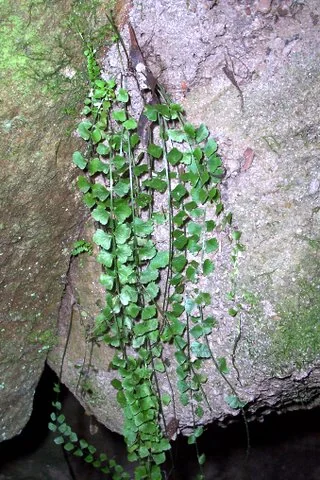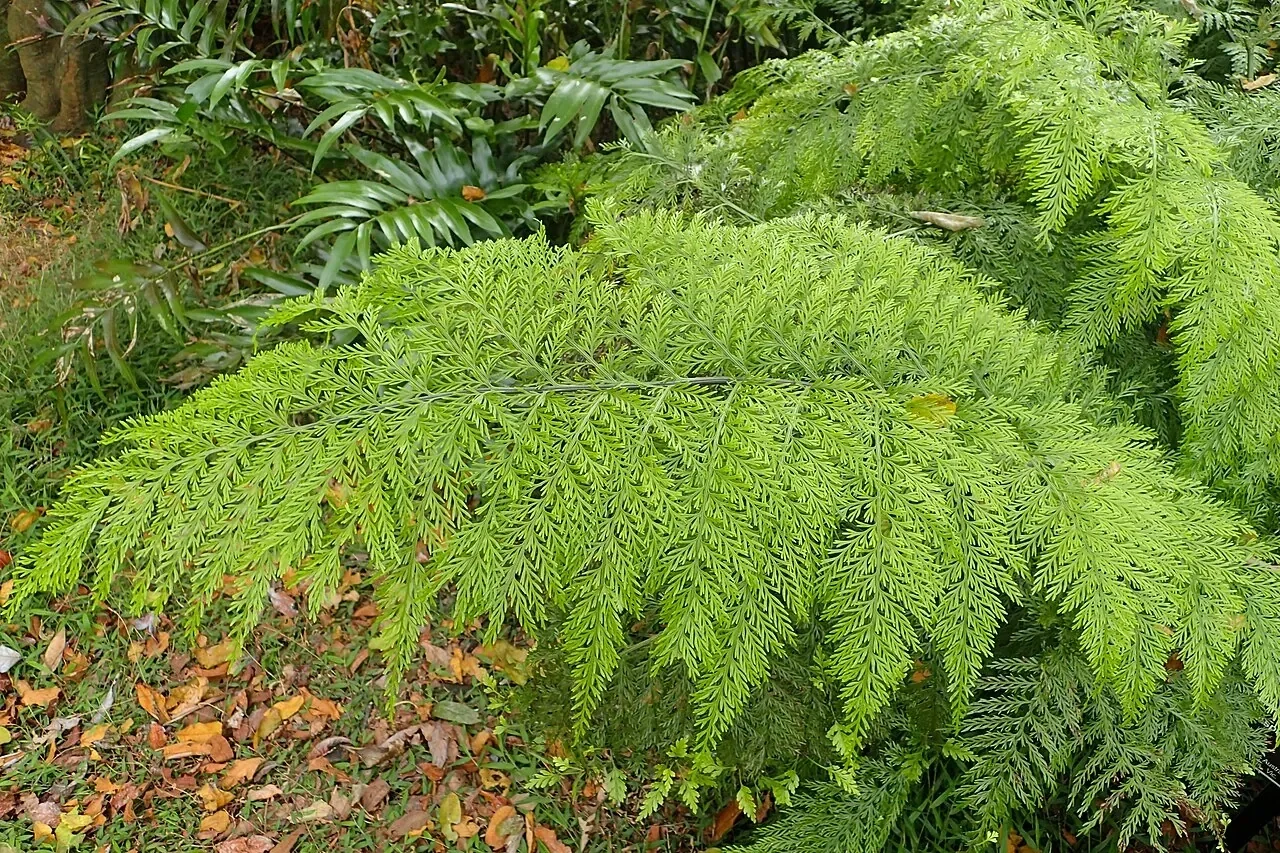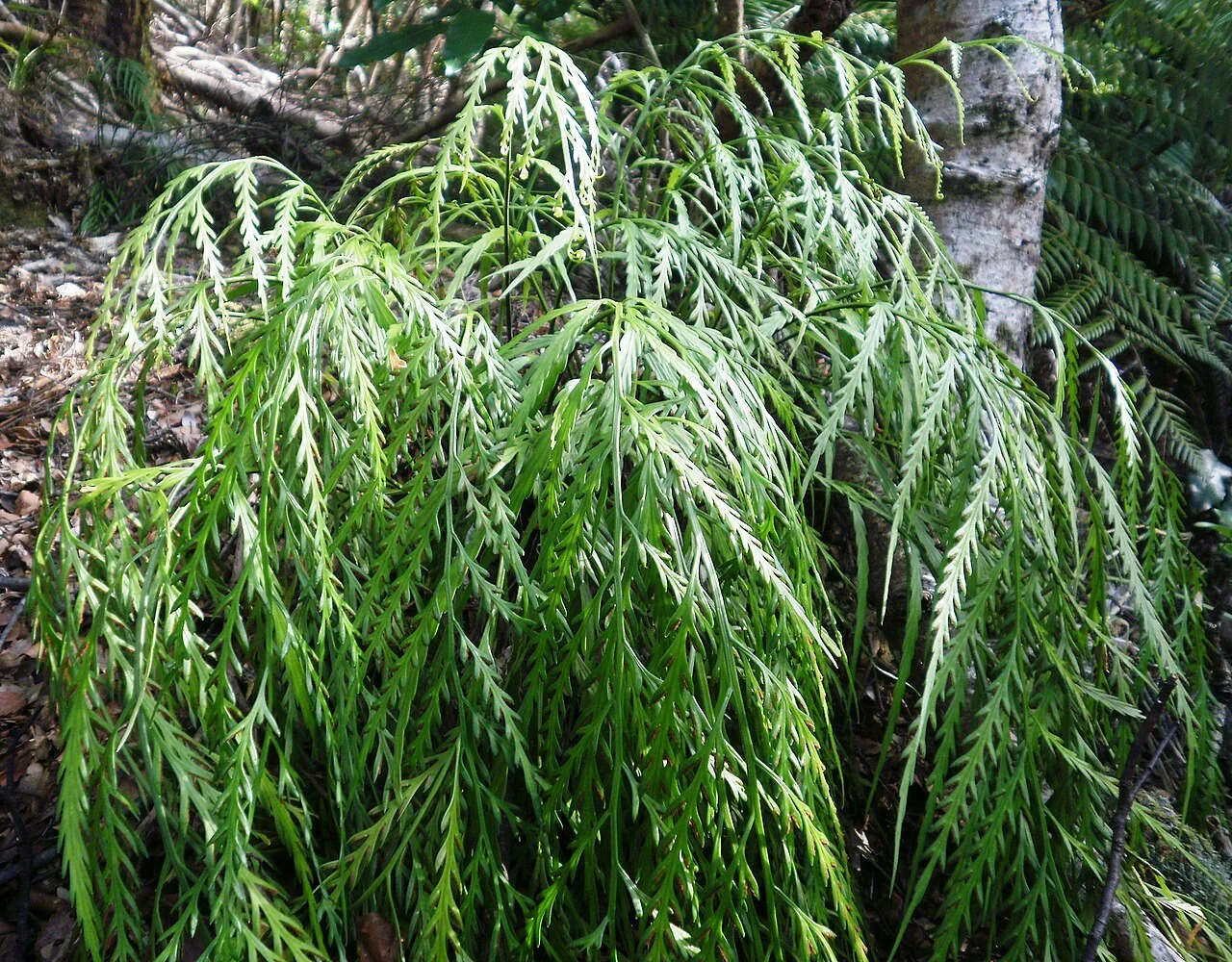
Necklace Fern
Asplenium flabellifolium
Explore more NZ native plant guides in our index .
Introduction
About Necklace Fern
Asplenium flabellifolium , commonly known as Necklace Fern or Butterfly Fern, is a delicate and distinctive native fern of New Zealand. It is characterized by its long, slender fronds with fan-shaped pinnae (leaflets) that often root at their tips, allowing the plant to "walk" across the ground and form new plantlets. This unique growth habit makes it an interesting addition to shady, moist areas in gardens.

Plant Description
Physical Characteristics
Necklace Fern ( Asplenium flabellifolium ) is a small, delicate fern characterized by its unique growth habit and distinctive fronds. It typically forms small clumps or spreads as a groundcover, rarely exceeding 30 cm in height.
The fronds are linear to narrowly oblong, usually 10-30 cm long, and composed of numerous fan-shaped or wedge-shaped pinnae (leaflets). These pinnae are often deeply lobed or toothed, giving the frond a lacy appearance. A key distinguishing feature is the presence of small plantlets (bulbils) at the tips of the fronds. As the fronds lengthen and touch the ground, these bulbils can root, allowing the fern to "walk" and establish new plants, hence its common name "walking fern."
The stipes (stalks) are slender, dark, and often shiny, contrasting with the bright green of the fronds. The sori (spore-producing structures) are linear and arranged along the veins on the underside of the pinnae.
This fern is evergreen in mild climates but may die back in colder conditions, regrowing from its rhizomatous rootstock in spring. Its delicate appearance belies a hardy nature, allowing it to thrive in various shaded, moist environments.
Quick Facts
Plant Summary
| Scientific Name | Asplenium Flabellifolium |
|---|---|
| Height | 10-30 cm |
| Spread | 30-50 cm |
| Water Needs | Moderate to high; prefers consistently moist soil |
| Light | Partial to full shade |
| Frost Tolerance | Moderate |
| Salt Tolerance | Low |
| Growth Rate | Moderate |
| Lifespan | Perennial |
Climate Best Suited to
Asplenium flabellifolium is found throughout New Zealand in damp, shady areas of forests, along stream banks, and on rocky outcrops. It thrives in a mild, humid climate with consistent moisture.
Regional Suitability
| Whangārei | Ideal |
| Auckland | Ideal |
| Hamilton | Suitable |
| Rotorua | Suitable |
| Tauranga | Ideal |
| Gisborne | Ideal |
| New Plymouth | Ideal |
| Whanganui | Ideal |
| Palmerston North | Suitable |
| Napier | Ideal |
| Wellington | Ideal |
| Nelson | Ideal |
| Christchurch | Suitable |
| Dunedin | Suitable |
| Invercargill | Suitable |
| City | Climate Suitability |
|---|
Natural Habitat
Native Environment and Distribution
Necklace Fern ( Asplenium flabellifolium ) is indigenous to New Zealand, where it is widespread throughout both the North and South Islands, as well as on some offshore islands. It is also found in parts of Australia and on some Pacific Islands, indicating its adaptability to a range of temperate and subtropical environments.
- Forest Floors and Margins: This fern commonly grows on the floors of damp, shaded forests, particularly in areas with high humidity. It can be found in both lowland and montane forests.
- Rocky Outcrops and Banks: Asplenium flabellifolium often colonizes rocky areas, including cliffs, rock faces, and stream banks, where its fronds can trail and root into crevices, taking advantage of accumulated moisture and organic matter.
- Epiphytic or Terrestrial: While primarily terrestrial, it can occasionally be found growing as an epiphyte on the lower trunks of trees, especially in very humid conditions.
- Soil Preferences: It thrives in well-drained, humus-rich soils that remain consistently moist. It is often associated with areas where leaf litter provides a constant supply of organic material.
- Adaptation to Disturbance: Its ability to root from frond tips allows it to colonize new areas effectively, making it somewhat resilient to minor disturbances in its habitat.
The Necklace Fern's preference for moist, shaded, and sheltered locations reflects its need for consistent humidity and protection from harsh sunlight and drying winds, typical of its native forest understory environment.
Plant Conservation
Threats and Efforts
Necklace Fern ( Asplenium flabellifolium ) is a native New Zealand fern with a national conservation status of "Not Threatened." This status has been consistently maintained across multiple assessments, indicating that the species is not currently at risk of extinction at a national level.
Despite its secure national status, local conservation efforts are important to protect its diverse habitats, which range from coastal areas to subalpine zones. The fern's ability to thrive on rocky ground, lava fields, and in moderately open forests demonstrates its resilience. However, like all native species, it can be vulnerable to habitat destruction and competition from invasive species in localized areas. Its unique "walking" propagation method, where frond tips root to form new plantlets, contributes to its natural spread and resilience. Promoting its cultivation in gardens and supporting the preservation of its natural environments are key ways to ensure the continued health and presence of this distinctive New Zealand fern.
Growing Requirements
Soil Requirements
Prefers moist, well-drained, humus-rich soil.
Light Requirements
Thrives in partial to full shade. Avoid direct sunlight, which can scorch the fronds.
Water Requirements
Requires consistent moisture, especially during dry periods. Do not allow the soil to dry out completely.
Planting Guide
-
When to Plant
Plant in autumn or spring.
-
Site Preparation
Choose a shady site with moist, well-drained, humus-rich soil.
-
Planting and Aftercare
Dig a hole twice the width of the pot. Place the fern in the hole, ensuring the crown is level with the soil surface. Backfill with soil and water thoroughly. Apply a layer of mulch.
Ecological Role
Native Ecosystem Importance
Necklace Fern ( Asplenium flabellifolium ) plays a subtle yet important ecological role within New Zealand's native forest ecosystems, particularly in maintaining understory health and biodiversity.
- Groundcover and Soil Protection: Its spreading habit, facilitated by tip rooting, allows it to form a dense groundcover. This helps to protect the soil from erosion, especially on slopes and banks, and reduces moisture loss from the forest floor.
- Microhabitat Creation: The fronds and rhizomes create a humid, sheltered microhabitat at ground level, which is beneficial for various small invertebrates, fungi, and microorganisms. These organisms contribute to nutrient cycling and decomposition within the ecosystem.
- Food Source: While not a primary food source for larger animals, the fern may provide sustenance for certain insects or other small fauna, contributing to the lower trophic levels of the food web.
- Indicator Species: The presence of healthy populations of Necklace Fern can indicate a thriving, moist, and relatively undisturbed forest understory, as it is sensitive to changes in humidity and light levels.
- Succession and Colonization: Its ability to "walk" and establish new plantlets from frond tips makes it an effective colonizer of suitable disturbed areas or new substrates, contributing to ecological succession.
The ecological contributions of Necklace Fern, though often overlooked due to its small stature, are vital for the intricate balance and health of its native habitats.
Uses and Significance
Garden Uses
- An excellent fern for shady borders, woodland gardens, rockeries, and containers.
- Its unique "walking" habit makes it a conversation piece.
Cultural Significance
Traditional Uses and Values
While not as widely documented for traditional Māori uses as some other ferns, the unique "walking" habit of the Necklace Fern ( Asplenium flabellifolium ) was observed and appreciated. Its presence in the landscape was a sign of a healthy, moist forest environment.
Landscaping Applications
Design and Application
Necklace Fern ( Asplenium flabellifolium ) is a charming and versatile fern that can be effectively used in various landscaping applications, particularly in shaded and moist garden settings.
- Groundcover: Its "walking" habit makes it an excellent choice for naturalizing areas, spreading gently to form a delicate groundcover in woodland gardens, under trees, or along shaded pathways. It helps to suppress weeds and adds a lush, green texture to the garden floor.
- Rock Gardens and Walls: The fern thrives in crevices and cracks, making it ideal for rock gardens, retaining walls, or between pavers in shaded areas. Its trailing fronds can soften hard edges and add a natural feel.
- Containers and Baskets: Due to its relatively small size and graceful, cascading fronds, Necklace Fern is well-suited for container planting, hanging baskets, or as a component in mixed shade planters. This allows its unique growth habit to be admired up close.
- Underplanting: It can be effectively used as an underplanting for larger native trees and shrubs, creating a layered effect and enhancing the natural aesthetic of a native plant garden.
- Edging: Its neat, low-growing habit makes it suitable for edging shaded beds or borders, providing a delicate and consistent green line.
When designing with Necklace Fern, consider its need for consistent moisture and shade to ensure it flourishes and contributes its unique beauty to your landscape.
Seasonal Care Calendar
Spring
- Apply a layer of compost or leaf mould to enrich the soil and retain moisture.
Summer
- Water regularly, especially during dry periods.
Autumn
- No special care required.
Winter
- Protect from heavy frosts in colder regions.
Pruning and Maintenance
Frond Maintenance
Remove any old, damaged, or yellowing fronds as needed to maintain the plant's appearance. Avoid trimming during periods when new growth could be affected by frosts. Practice periodic light maintenance rather than infrequent severe cutting. Allow frond tips to root naturally if you want the plant to "walk" and establish new colonies, which is a unique characteristic of this necklace fern species.
How to Grow Necklace Fern
Tip Rooting
Tip rooting is the most distinctive and effortless propagation method for Necklace Fern, taking advantage of the species' unique ability to produce new plants from the tips of its drooping fronds, which gives it one of its alternative common names "walking fern." This remarkable characteristic allows the fern to spread naturally across suitable surfaces, creating expanding colonies with minimal intervention. The flaccid, fan-shaped fronds naturally arch and droop under their own weight, bringing their tips into contact with moist soil, rocks, or other suitable growing surfaces. When environmental conditions are favorable, these tips develop small root systems and eventually form independent plantlets while still connected to the parent plant. To encourage tip rooting, simply guide healthy, mature fronds so their tips come into contact with moist, organic-rich soil or suitable growing medium. Small stones or wire pins can be used to gently hold the frond tips in place if necessary, ensuring good contact without damaging the delicate tissue. The rooting process typically begins within 2-4 weeks during favorable growing conditions, with small white roots emerging from the tip followed by the development of tiny new fronds. Once the new plantlet has developed a substantial root system and several small fronds, it can be carefully severed from the parent frond using sharp, clean scissors. The newly independent plant should be kept in consistently moist conditions with high humidity for several weeks until it becomes fully established. This natural propagation method requires no special equipment or growing medium, making it ideal for gardeners of all skill levels and particularly valuable for creating ground-covering colonies of this attractive native fern in shaded garden areas.
Division
Division provides a reliable and straightforward method for propagating established Necklace Fern clumps, particularly effective when multiple new plants are needed quickly or when rejuvenating older specimens that may have become overcrowded. This small fern naturally forms expanding clumps through underground rhizome growth, creating multiple crowns that can be carefully separated to form independent plants. The optimal timing for division is during spring when new growth is beginning to emerge, allowing divided sections to establish quickly in favorable growing conditions. Begin by carefully lifting the entire clump using a small hand fork or trowel, working gently around the perimeter to avoid damaging the delicate root system and emerging fronds. Necklace Fern has a relatively shallow and compact root system compared to larger fern species, making it easier to handle but requiring extra care to prevent damage. Once lifted, gently shake away excess soil to expose the rhizome structure and identify natural divisions where separate growing points have developed. Use clean, sharp knife or small pruning shears to cut through connecting rhizomes, ensuring each division includes both healthy roots and at least one active growing point with visible fronds or emerging shoots. Divisions can be quite small, as this species establishes readily from minimal root material provided adequate moisture and protection are maintained during establishment. Replant divisions immediately in prepared soil enriched with leaf mold or compost, positioning them at the same depth they were previously growing. Choose locations with consistent moisture, protection from direct sunlight, and good air circulation to prevent fungal problems during establishment. Water thoroughly after planting and maintain consistent soil moisture throughout the establishment period, typically 6-8 weeks during favorable conditions. This method is particularly useful for indoor cultivation where controlled conditions can be maintained, and for creating multiple plants for rock gardens or containers where the fern's distinctive fan-shaped pinnae can be appreciated at close range.
Spores
Spore propagation offers the most natural reproductive method for Necklace Fern, though it requires more patience, skill, and controlled conditions than the vegetative propagation methods. This approach is particularly valuable for conservation purposes, scientific study, or when working with limited plant material where other propagation methods are not feasible. Necklace Fern produces spores in elongate sori (spore clusters) on the undersides of mature fronds, typically ripening during late summer to autumn when environmental conditions are most favorable for spore development. Monitor the undersides of healthy, mature fronds for the presence of brown, elongated sori, which indicate spore maturity. For collection, cut selected fronds when the sori have turned brown but before they have burst and released their spores naturally. Place the cut fronds in clean, white paper bags and store in a warm, dry location for several days to allow natural spore release. Fresh spores appear as fine, dust-like particles and should be sown immediately for optimal germination rates. Prepare a sterile growing medium using equal parts sphagnum peat moss, finely chopped sphagnum moss, and perlite, and sterilize by pouring boiling water over the mixture and allowing it to cool. Sow spores thinly on the surface of the cooled, moist growing medium in shallow containers, covering with glass or clear plastic to maintain high humidity levels. Maintain consistent temperatures between 18-22°C with bright, indirect light, ensuring the growing medium remains consistently moist but not waterlogged. Germination is typically slow and irregular, taking several weeks to months for the initial green, heart-shaped prothallus stage to develop, followed by many more months for recognizable fern plants to emerge. Young sporophytes require careful attention to humidity, light levels, and protection from contamination throughout their development, making this method more suitable for experienced fern enthusiasts rather than casual gardeners.
Tip Layering
New plantlets can be formed by pinning the frond tips to the soil.
Pests and Diseases
Vulnerable Croziers
Generally trouble-free, but keep an eye out for slugs and snails which love the tender new fronds (croziers). In indoor or sheltered spots, scale insects can sometimes infest the stems; treat with a gentle horticultural oil or wipe off.
Bonus Tip
Encouraging "Walking" Growth
To fully appreciate the unique "walking" habit of the Necklace Fern ( Asplenium flabellifolium ), you can actively encourage its spread in your garden.
As the fronds mature and develop plantlets at their tips, gently guide these tips to touch moist soil or a suitable substrate. You can lightly pin them down with a small stone or a U-shaped wire. This direct contact with moisture and soil will encourage the plantlets to root more readily, allowing the fern to establish new colonies and create a beautiful, naturalized effect in your shaded garden areas.







